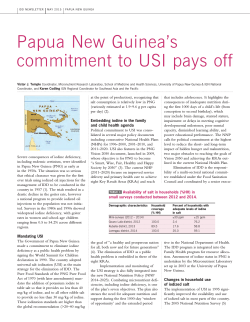
I Dr. Hans Eggenberger Pioneers in Thyroid AG Unnikrishnan
70 Journal of the association of physicians of india • vol 62 • november, 2014 Pioneers in Thyroid Dr. Hans Eggenberger AG Unnikrishnan* The Iodine Story I odine is essential for thyroid hormonestriiodothyronine (T3) and tetraiodothyronine (T4) contain 3 and 4 iodine atoms respectively. The link between iodine deficiency and thyroid diseases was uncovered long back. Iodine deficiency, it was found, could lead to goiter (enlarged thyroid gland) and hypothyroidism at any age. Iodine deficiency could also cause neurointellectual problems in children (cretinism) and delayed physical development in growing children. 1 It was also noted that persons living in iodine-deficient areas were most at risk. This included the Himalayas, Andes and the Alps. This led to the thought that iodine supplementation could prevent iodine defciency disorders. Switzerland was the pioneering country, which instituted the iodine supplementation program in 1922. Whle a number of dedicated professionals were instrumental for this program, this article will focus on the efforts of Dr. H. Eggenberger, a surgeon, who, with his family led the fight against iodine deficincy. A Swiss Odyssey Chief Endocrinologist and CEO, Chellaram Diabetes Institute, Pune * T r a ve l s b y s e ve r a l e x p e r t s h a ve documented that the mountaneous regions of Switzerland had a significant burden of people with endemic goiter. Even the celebrated author, Mark Twin wrote, “I have seen the principal features of Swiss scenery—Mount Blanc and the goiter—and now for home.” It was eventually the Swiss Army- which used to classify people as unift because of goiter, who discovered that the mountaneous districs of Switzerland had more goiter than the plains. Soon, studies in the early 1900s were now showing that over 80% of young men and 60% of school children had goiters. The relationship between iodine and the goiter was soon becoming apparent in studies. Preliminary studies by Dr O Bayard, a brilliant doctor from Switzerland- set the stage for an iodine replacement program. 1 It was at this time that Hans Eggenberger (1881-1946), a surgeon in Herisau, Switzerland, decided to do something about it. Swiss Time In country celebrated for its celebration of time through quality watches, the timing of Dr. Hans Eggenberger too could not have been more perfect. He soon began a campaign to improve iodine nutrition. And then, going a step further- he petitioned the government to introduce iodized salt. It is not known whether he realized that this petition would lead to a successful campaignand that iodization of salt would soon benefit several countries, even Indiain preventing the scourge of iodine deficiency disorders. The petition by Hans Eggenberger was succesful, and the Swiss government in 1922 agreed to allow the the distribution of salt containing 7.5 mg iodine per kg. 1-3 For Hans Eggenberger, the fight against iodine deficiency was as much personal, as it was professional. Indeed, his entire family would together to prepare the iodized salt. 71 Journal of the association of physicians of india • vol 62 • november, 2014 The Succesful Program The Movement Spreads The iodization program was hugely succesful. In a year’s time, among the families who used iodized salt regularly - 66% of existing goiter in school children shrank. After 4 years of iodized salt prophylaxis, the average size of pre-existing goiters had shrunk to an invisible or normal level ! The most dramatic result was that in a few years, there were no cases of newborn goiters reported ! This led the Swiss Government to form an advisory council – to take the program ahead, systematically, countrywide. Though opposition came from opposing lobbies as well as an attack of hyperthyroidism- the benefits of iodine prophylaxis were soon recognized in Switzerland and other countries of Europe. Further benefits were noted following the efforts of Dr. Eggenberger- the prevalence of army recruit goiter reduced, prelanence of mental deficiency declined and the prooportion of people with a shorter height (defined as below 156 cm) also decreased. Iodization of salt became the most cost-effective public health measure ever conducted succesfully in Switzerland. Dr. Eggenberger’s contribution is unique, for this represents a clinician, whose vision and actions became a harbinger of worldwide change in health. It also represents the succesful efforts of a doctor as an advocate for a preventive health program. The fantastic succces of the program kindled by Dr. Eggenberger sent ripples worldwide, and theos was soon felt in India too. Dr Ramalingaswami and Dr N Kochupillai soon pioneered the iodization of salt in India. 4 Universal salt iodisation was on its way to becoming a reality. References 1. Papageorgopoulou C, Staub K, and Rüh F. Hypothyroidism in Switzerland. In: Harbeck M, Von Heyking K, Schwarzberg H, eds. Sickness, Hunger, War, and Religion. Munich: Rachel Carson Center for Environment and Society 2012, Pages- 1-90. Link - http:// xn--evolutionremedizin-ttb.ch/wp/wp-ontent/uploads/2012/08/ Papage_Staub_Ruehli_2012.pdf Accessed 10th May, 2014 2. Eggenberger, Hans. 1922. “Die Verhütung des Kropfes und des Kropfrecidives.” Schweizerische Medizinische Wochenschrift 53: 245–49. 3. Hans Eggenberger (1881–1946). http://www.tagblatt.ch/ostschweiz/ stgallen/rheintal/rt-ur/Ein-Segen-fuer-Kropflis;art166,3077080. Accessed 10th May, 2014 4. Sooch SS, Deo MG, Karmarkar MG, Kochupillai N, Ramachandran K, Ramalingaswami V. Prevention of endemic goitre with iodised salt. Bull WHO 1973;49:307-312.
© Copyright 2025





















